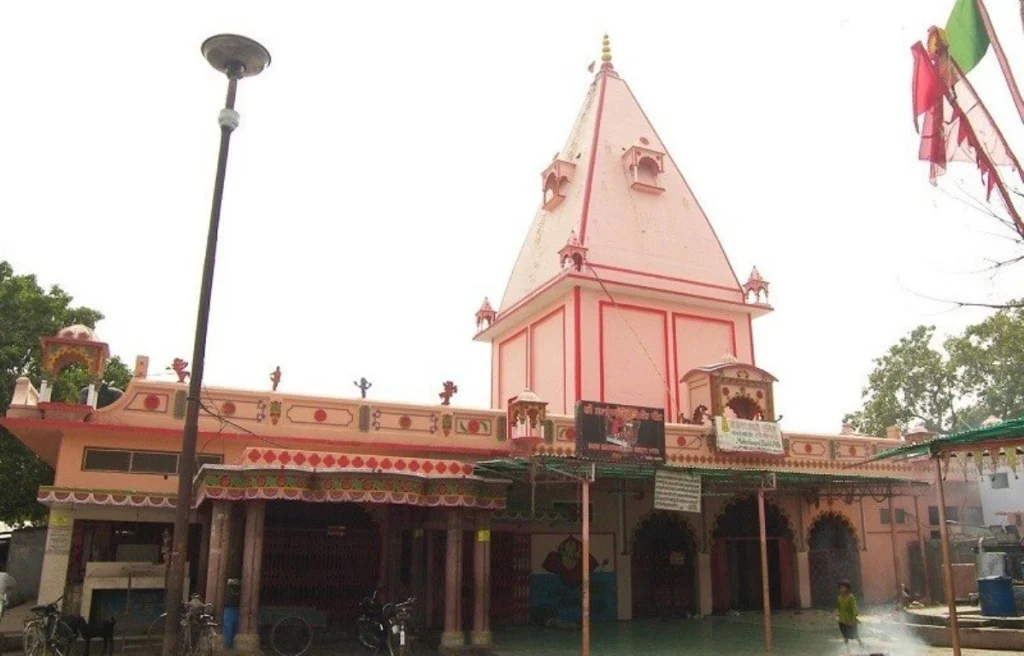The Alopi Devi Temple is a Hindu temple in Prayagraj, Uttar Pradesh, famous for worshiping Goddess Sati without an idol. Instead, devotees honor a sacred wooden cradle called a ‘doli’. It is an important Shakti Peeth, believed to be the spot where a part of Sati’s body fell. The name “Alopi” means “to vanish”, referring to the mysterious disappearance of the goddess from the cradle. The temple is located near the Triveni Sangam and becomes a major center of devotion during the Kumbh Mela.
Mythology
According to the Hindu Puranas, Sati, the daughter of Prajapati Daksha, married Shiva against her father’s wishes. Daksha performed a grand yajna (sacrifice) but did not invite Sati or Shiva. Even so, Sati went to the yajna, where Daksha ignored her and insulted Shiva. Unable to bear the insult, Sati offered herself into the fire. Filled with grief, Shiva wandered the universe carrying her half-burnt body. At last, Vishnu used his Sudarshan Chakra to cut her body into 51 parts, which fell on different places across the earth. Each of these places became Shakti Peethas.
The fingers of Goddess Sati are believed to have fallen and vanished here, giving birth to the name “Alopi” (disappeared). Here, in place of an idol, a cradle (“doli”) symbolizes her divine presence.
Another version speaks of a bride who vanished from her wedding carriage when bandits attacked. No trace remained. Locals built a shrine at that spot, venerating her as the virgin goddess who disappeared.
You may also explore four Adi Shaktipeethas: Vimala, Tara Tarini, Kamakhya and Kalighat.
Historical Background of Alopi Devi Temple
The Alopi Devi Temple represents a rare continuity of worship that blends mythic origins with verifiable historical developments. References to the sacred site appear in 17th- and 18th-century regional records related to Alopibagh, a locality named after the deity, even though legend obscures the temple’s exact foundation date.
Documentary evidence suggests that the temple gained structural prominence during the late 18th century under the patronage of Maratha warrior Shreenath Mahadji Shinde. Following the Maratha foothold in northern India after the Third Battle of Panipat (1761), Shinde undertook several religious and civic projects in Prayagraj, with Alopi Devi Temple among them.
The structure saw further expansion and embellishment in the early 19th century, notably under Maharani Baizabai Scindia, whose renovations reinforced the temple’s role as a Shakti worship center during the British colonial period.
Colonial-era gazetteers of the United Provinces mention Alopi Devi Temple as a focal point during Navratri festivities and as part of the religious landscape linked to the Sangam pilgrimage route. These records, while brief, confirm the temple’s recognized status within both local devotion and broader regional pilgrimage traditions.
Architecture of Alopi Devi Temple
The Alopi Devi Temple’s architecture combines the Nagara style of the 11th century with Islamic features like chhatris and jali work. These blend beautifully with Hindu elements such as the shikhara and mandapa. Instead of a traditional idol, the sanctum holds a symbolic wooden palanquin (doli).
The superstructure follows a simplified Nagara-style shikhara, common in the Gangetic plains during late-medieval temple construction. Unlike the heavily ornamented Nagara spires of Khajuraho or Bhubaneswar, the shikhara here remains understated, likely shaped by functional needs and the temple’s local devotional culture. Its surface bears minimal sculptural work, emphasizing painted motifs rather than carved stone-indicative of 18th–19th century regional temple-building trends.
The garbhagriha (sanctum) is a compact, square chamber accessed through a modest mandapa (pillared hall). The flooring consists of large sandstone slabs, weathered smooth over centuries by pilgrim footfall. Subtle wear patterns suggest continuous use, making this one of the most enduringly active ritual sites in Prayagraj.
Plans are underway to add South Indian-style features, including a Yagya Kund and a large platform, in preparation for the Maha Kumbh Mela 2025.
Materials Analysis
The temple incorporates locally quarried Chunar sandstone, a hallmark of many historical buildings in the region, including the nearby Allahabad Fort. This stone, prized for its fine grain and durability, reveals under microscopic examination the distinctive tool marks of traditional hand-chiseling methods.
Interestingly, the temple’s peripheral walls have undergone multiple restorations, visible in the variation of stone coloration and mortar types-evidence of ongoing preservation efforts through Maratha, British, and post-independence periods. The latest paintwork in bright saffron and red adheres to the temple’s living heritage rather than archaeological purism, reflecting its role as a living place of worship rather than a purely preserved monument.
The true uniqueness lies not in monumental grandeur, but in the cultural layering-a sacred site shaped by centuries of adaptation, yet holding fast to a singular, non-iconic representation of divinity. This continuity of intangible heritage alongside tangible architecture makes Alopi Devi Temple a rare and valuable case study in living religious archaeology.
Geographical Location of Alopi Devi Temple
The Alopi Devi Temple stands in the quiet yet spiritually charged neighborhood of Alopibagh, in southern Prayagraj, Uttar Pradesh. It sits just about 3 km from the Sangam, where the Ganga, Yamuna, and the mythical Saraswati river meet-a spot revered by millions.
Here’s a quick overview:
| Aspect | Details |
|---|---|
| Coordinates | 25.4205° N, 81.8781° E |
| State | Uttar Pradesh |
| District | Prayagraj |
| Elevation | ~608 feet above sea level |
If you’re exploring on foot from the Sangam area, it’s a pleasant short walk through bustling lanes lined with sweet shops, flower vendors, and pilgrims heading for the morning darshan.
How to Reach Alopi Devi Temple
Reaching Alopi Devi Temple, Prayagraj is simple and convenient, thanks to its central location in the city.
By Air:
The nearest airport is Prayagraj Airport (IXD) approximately 12 kilometers from the city of Prayagraj and the temple.
By Train:
The nearest railway hub is Prayagraj Junction (formerly Allahabad Junction), about 6 km away. Autos and taxis are easily available.
By Road:
Prayagraj is well connected by highways to major cities like Varanasi, Ayodhya, and Lucknow.
Where to Stay in Prayagraj
Prayagraj offers everything from budget lodges to premium hotels. For spiritual travelers, I recommend staying near Civil Lines or Triveni Sangam.
Hotel Prayag: 73, Noorullah Rd, near Prayagraj, junction, Miurabad, Prayagraj, Uttar Pradesh 211003
Max Hotel Prayagraj: Multi Functional Complex , Civil Lines Railway Station Compound, Prayagraj, Uttar Pradesh 211001
Hotel Saket: Mahatma Gandhi Marg, Civil Lines, Prayagraj, Uttar Pradesh 211001
Best Time to Visit Alopi Devi Temple
The best time to visit Alopi Devi Temple, Prayagraj is between October and March, when the weather is cool and pleasant. During these months, morning and evening darshan feel especially serene, and exploring nearby attractions like the Sangam becomes more enjoyable.
If you want to experience the temple’s vibrant spiritual energy, plan your trip during:
- Navratri (March–April and September–October) – During this period, the temple comes alive with vibrant floral decorations, dazzling lights, and the resonant sounds of devotional music. Large crowds gather for special prayers and rituals.
- Tuesdays & Fridays – Considered auspicious for Goddess worship, these days see a higher flow of devotees, thread-tying rituals, and special offerings.
- Magh Mela (January–February) – Although the area bustles with pilgrims heading to the Sangam, the vibrant atmosphere and deep spiritual energy make it an unparalleled experience.
✅ Summers in Prayagraj (April–June) can get extremely hot, often crossing 40°C. If visiting during this time, arrive early in the morning or late in the evening to avoid the heat. Monsoon season (July–September) brings heavy rain, which can make travel and walking in the temple lanes challenging.
Alopi Devi Temple Timings
The temple is open every day of the week, allowing devotees to seek the blessings of Goddess Alopi. It opens at 5:00 AM and closes at 10:00 PM.
| Opening Time | 5:00 AM |
| Closing Time | 10:00 PM |
Festivals
Festivals at Alopi Devi Temple, Prayagraj are not just religious events-they are immersive cultural experiences where devotion, color, and community come together. The temple’s unique identity as a Shakti Peetha makes it a focal point for several important celebrations throughout the year.
Navratri (Chaitra & Sharad)
Held twice a year-in March–April and September–October-Navratri is the temple’s grandest celebration. The goddess’s cradle (doli) is draped in vivid red and gold cloth, adorned with marigold garlands, and illuminated by shimmering lights. Devotees gather for aarti, bhajans, and yagna (fire rituals), with priests chanting Durga Saptashati verses. The air is thick with the aroma of incense, and evenings see cultural performances dedicated to the Goddess.
Tuesdays & Fridays
These days hold weekly significance for Shakti worship. Many women visit to tie sacred threads (rakshasutra) near the sanctum, seeking blessings for family protection, health, and prosperity. The temple also distributes prasad of sweetened gram flour (boondi) on these days.
Magh Mela
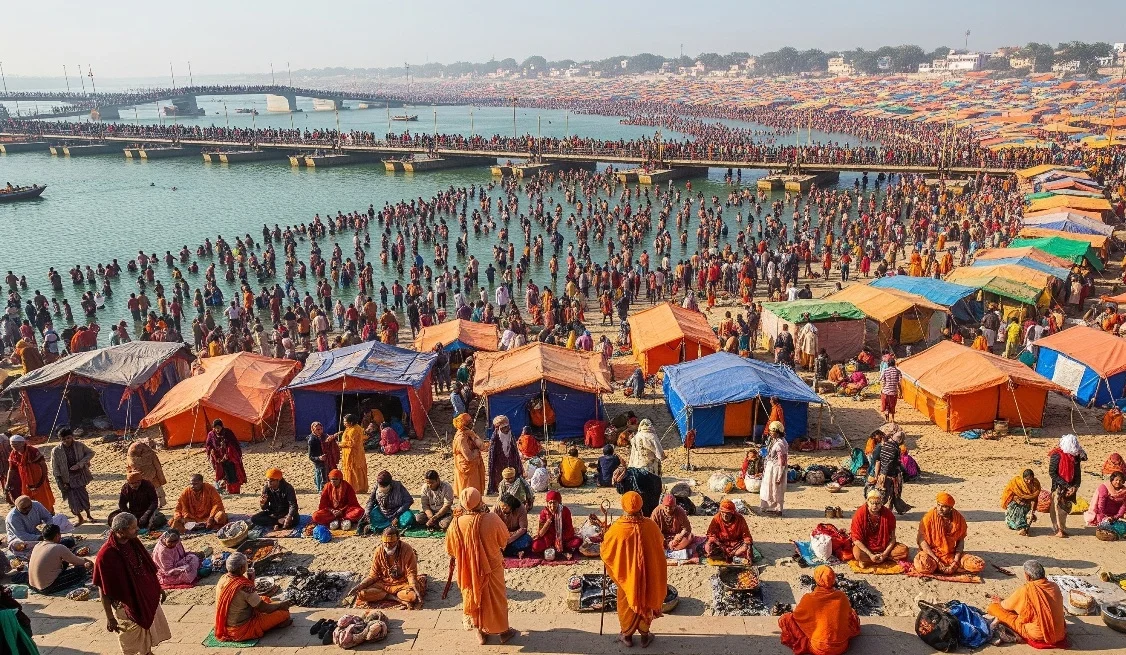
Coinciding with January–February, the Magh Mela transforms Prayagraj into a vast pilgrimage city. While most activities center on the Sangam, Alopi Devi Temple witnesses an influx of pilgrims who combine their holy dip with a visit to the goddess’s shrine. The temple authorities make special arrangements, extend darshan hours, and enhance security measures.
Other Local Fairs & Celebrations
The temple occasionally hosts community events tied to the lunar calendar, such as Kartik Purnima and Shivratri. During these occasions, devotees ritually bathe and re-decorate the cradle. These celebrations remain quieter than Navratri but hold deep spiritual significance for regular visitors.
Insider’s Tip: If you enjoy a vibrant atmosphere, visit during Navratri. If you prefer a more intimate, meditative experience, choose a regular weekday morning outside the festival season.
Local People & Culture
The local people belong to the larger community of Prayagraj, a city known for its mixed culture influenced by Hinduism, Islam, Jainism, and Christianity.
For the residents of Alopibagh, the cradle of the goddess is more than a sacred relic-it is a living protector of the neighborhood.
Tuesdays and Fridays are special. Women in bright saris tie rakshasutra (sacred threads) to nearby railings, asking for the goddess’s grace in family matters, health, or safe travel.
People in this area live deeply rooted in Hindu traditions while welcoming pilgrims from across India. Many speak of the cradle’s power to grant protection during illness, difficult journeys, or family crises. Various rituals take place at the temple, including the mundan (head-shaving ceremony) for children.
Nearby Attractions
Triveni Sangam
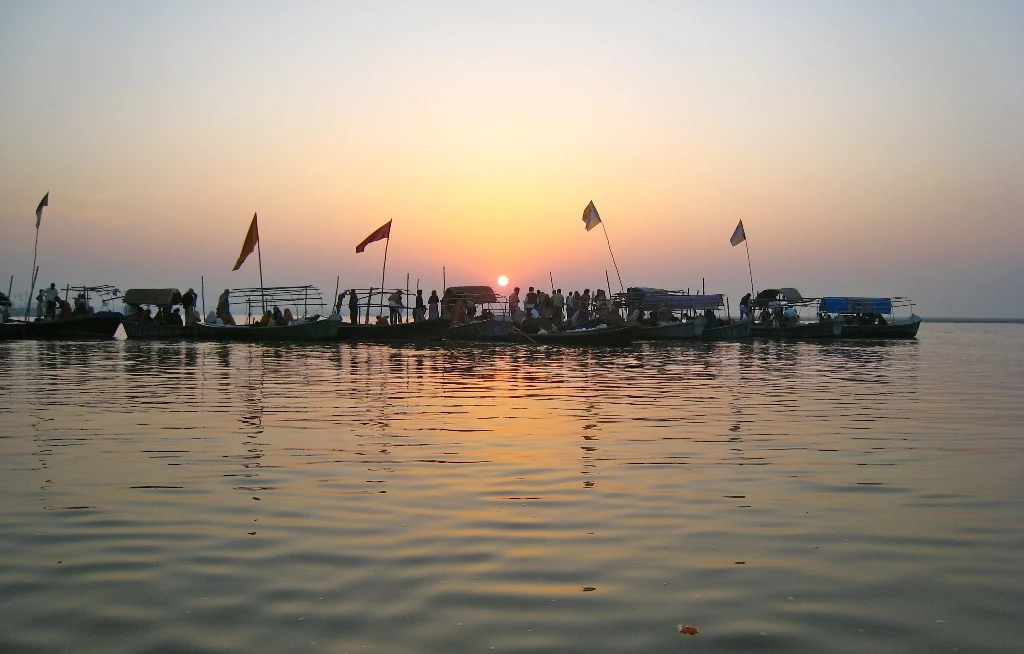
Triveni Sangam is the confluence of three rivers – the Ganga, Yamuna, and the mythical Saraswati – in Prayagraj (formerly Allahabad), Uttar Pradesh, India. Hindus revere this place deeply, and it draws both pilgrims and tourists. The confluence forms a Triveni Tirtha, where three rivers merge, symbolizing the union of three aspects of divinity.
Lalita Devi Temple
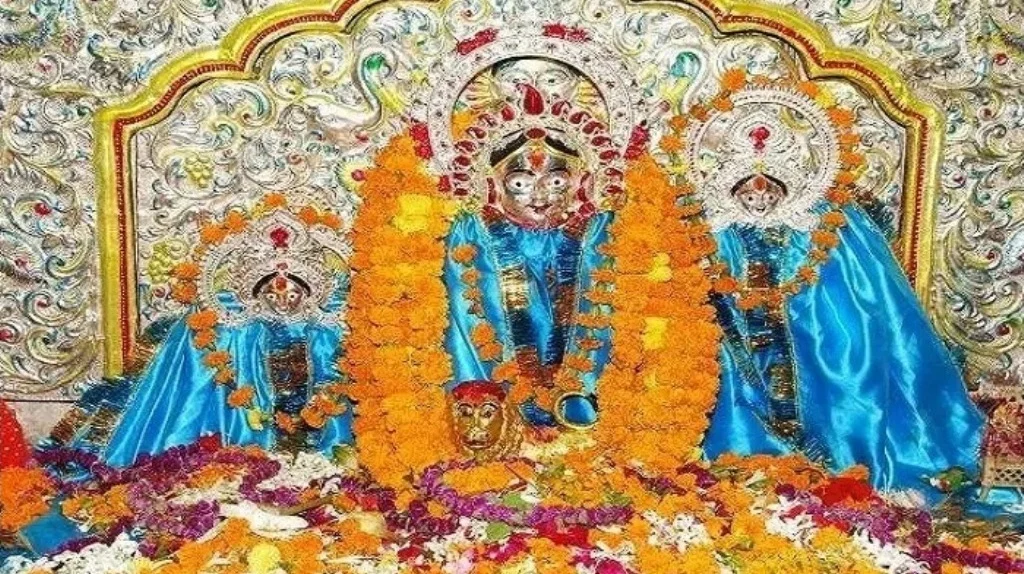
Hidden quietly in the spiritual heart of India, Lalita Devi Temple, Prayagraj stands as an overlooked yet potent powerhouse of divine feminine energy. It is nearly 6.6 km away from Alopi Devi Temple. Route map is given below.

According to ancient belief, Sati’s finger fell at Prayagraj, sanctifying the site as a Shaktipeetha. Devotees revere Goddess Lalita Devi as an incarnation of Mahashakti-a fierce yet compassionate mother who protects her followers and grants their wishes. Scriptures like the Matsya Purana reference this temple as one of the three most powerful Shaktipeethas, alongside those in Kashi and Vindhyachal.
Allahabad Fort
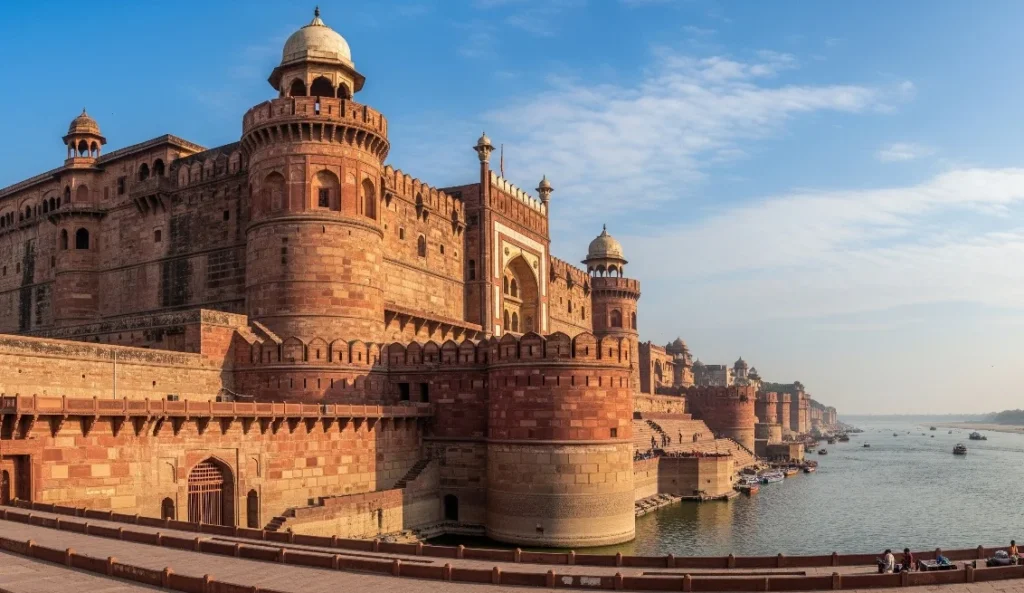
Mughal emperor Akbar built Allahabad Fort at Allahabad in 1583. The fort stands on the banks of the Yamuna, near its confluence with the Ganges. It is classified by the Archaeological Survey of India as a monument of national importance.
Khusro Bagh
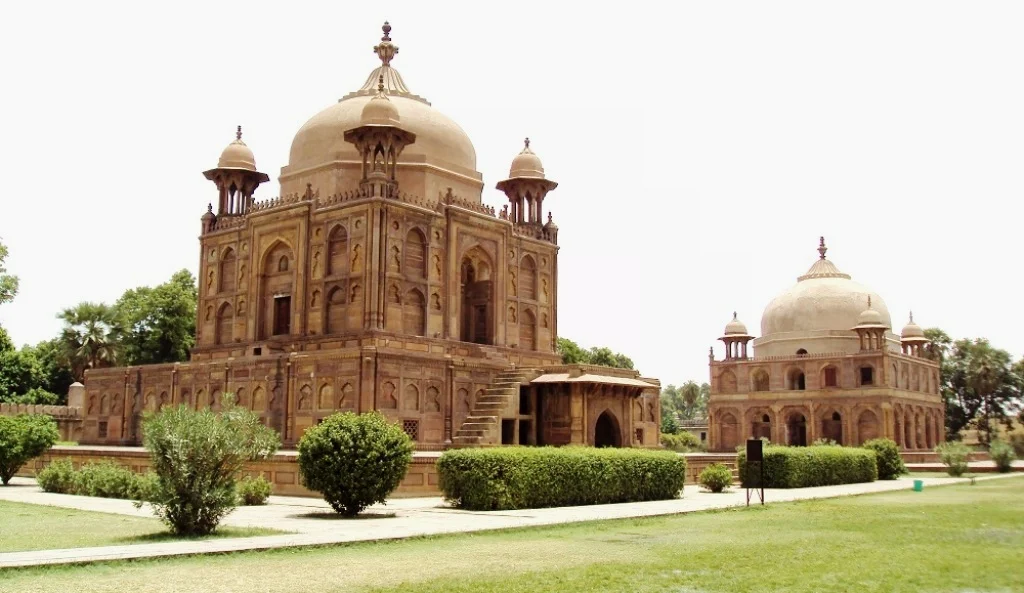
Khusro Bagh is a large walled garden and burial complex located in muhalla Khuldabad, close to the Prayagraj Junction railway station, in Prayagraj, India. It is roughly 6 km from the Akbar fort. The garden is situated over forty acres and shaped like a quadrangle. It is listed as an Indian Site of National Importance.
Anand Bhavan
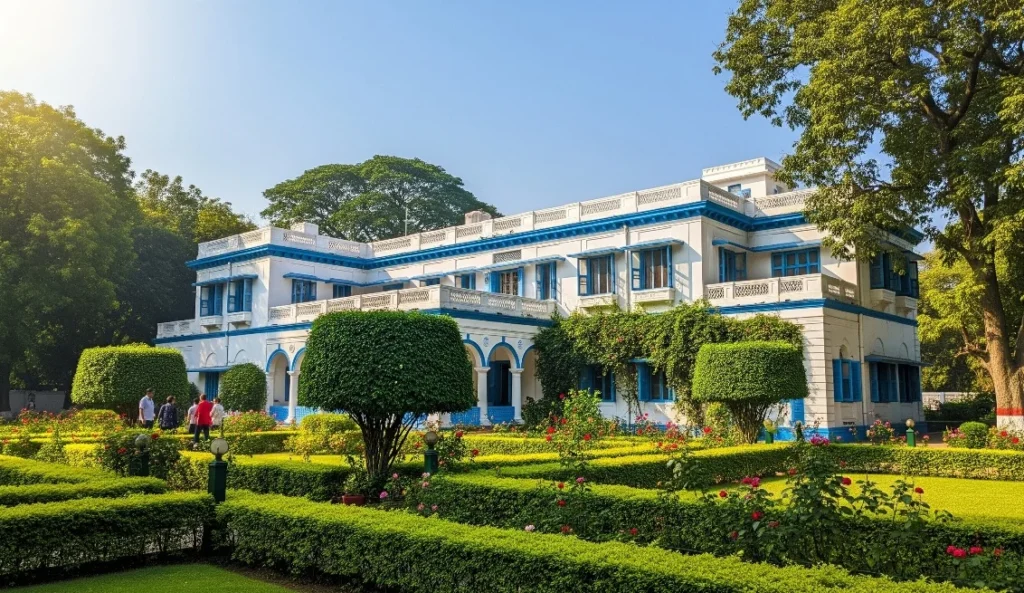
The Anand Bhavan is a historic house museum in Prayagraj, India, focusing on the Nehru family. It was bought by Indian political leader Motilal Nehru in the 1930s to serve as the residence of the Nehru family when the original mansion Swaraj Bhavan (previously called Anand Bhavan) was transformed into the local headquarters of the Indian National Congress.
Conclusion
The Alopi Devi Temple, Prayagraj isn’t about grand idols or ornate carvings-it’s about the invisible, the unspoken. The cradle whispers of legends, loss, miracles. Visiting it is personal, mystical, grounding.
If you’re someone seeking spiritual renewal, or just wish to explore an authentic, lesser-known Shaktipeetha, this temple deserves a place on your journey map. It transformed my understanding of devotion-from ritualistic to personal.
Frequently Asked Questions (FAQs)
Alopi Devi Temple is located in Alopibagh, Prayagraj (Allahabad), near the sacred Triveni Sangam where the Ganga, Yamuna, and mythical Saraswati rivers converge. It’s easily accessible from the city center via auto-rickshaw, taxi, or private vehicle.
The temple remains open from early morning to around 10 PM-with sources noting timings like 4 AM to 10 PM or 6 AM to 10 PM. Tuesdays and Fridays draw large numbers of devotees.
Redditors and travelers often highlight the temple’s accessibility and spiritual atmosphere.
“Alopi Devi Mandir… a wooden chariot… thousands… come to worship.”Reddit
One visitor noted their walk from the temple to the Sangam-a journey enveloped in devotion.
Devotees venerate the wooden doli covered in red cloth. Beneath it lies a small well on a raised platform, where a Sri Yantra is installed. The well’s water is believed to have medicinal properties, particularly for skin ailments.
Unlike typical idols, this temple worships an empty wooden cradle (doli), symbolizing the place where Sati’s remains vanished-hence the name “Alopi” (meaning disappeared).

